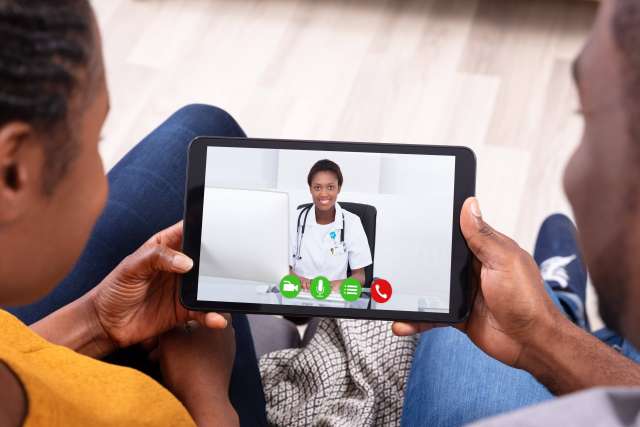During the COVID-19 pandemic, many UCLA Health patients have avoided the physically distanced chairs of clinic waiting rooms and instead seen their doctors from the comfort and safety of their own couch.
Telehealth has expanded dramatically in the past year, and UCLA Health researchers expect that virtual visits are here to stay even after the coronavirus subsides.
Daniel Croymans, MD, and Maria Han, MD, analyzed the rapid increase in video and phone visits. They also surveyed UCLA Health primary care doctors on what health concerns can best be served remotely and what patients are most likely to struggle with a video or telephone visit.
In late December, they published a paper in the journal NEJM Catalyst Innovations in Care Delivery with their recommendations for ensuring patients are treated in the most appropriate setting.
“This pandemic has offered a great opportunity to see what the impact of this new modality of care delivery is for patients and the practice of medicine,” said Dr. Han, chief quality officer for the department of medicine. “I think it’s really exciting.”

Before the pandemic, less than 1% of medical appointments at UCLA Health were virtual. But the practice took off in March after the Centers for Medicare and Medicaid Services expanded coverage for telehealth. By April, as patients increasingly canceled in-person appointments, virtual visits surged to 55%.
Currently, they represent about 25% of all medical appointments.
“Interestingly, telemedicine has, in a way, brought many physicians back to the days when we would regularly visit patients in the comfort of their own homes,” said Dr. Croymans, medical director of quality for the department of medicine. “It is only through my video visits with patients that I have met so many family members and seen firsthand the environments in which my patients live. These social determinants make me a better physician.”
Dr. Han said televisits eliminate the need for patients to battle traffic or worry about finding parking, which is especially important for those with limited mobility or complex conditions.
“If we can see patients and effectively connect with and evaluate them through a video visit, for example, that is much better from a convenience perspective and functional perspective for many of our patients,” Dr. Han said. “It’s been very well received and patients are grateful to have the opportunity, especially during the pandemic, to do a visit through video or the phone.”
Drs. Han and Croymans twice surveyed primary care physicians about their experience with the transition to telehealth. Their colleagues reported that the most appropriate health concerns for a virtual visit were depression/anxiety, cough/congestion and diabetes management.
The least appropriate times for a telehealth visit, the survey found, were if a patient was experiencing chest pain, shortness of breath and ear pain/hearing changes.
“For things like ear pain or abdominal pain, a physical exam can be a critical part of understanding the nature of the patient’s problem,” Dr. Han said. “For other things like depression, for example, the patient’s experience of the problem can often be effectively relayed through conversation over the phone.”
Drs. Croymans and Han are developing a triage protocol pilot project that will direct patients and call center schedulers to book the type of appointment best suited to the particular medical need. The screening tool, which will likely launch in the spring at UCLA Health, will identify “red-flag” symptoms that may require emergency care, as well as best direct patients to urgent care, a regular clinic visit or a virtual appointment.
“Now that we realize care can actually be provided in a high quality way virtually, we have to figure out which type of care is best,” Dr. Croymans said. “It’s not a solution that can be applied to everything. It’s overall a really fantastic medium for us and for patients but there’s a little bit of nuance that needs to be worked out still.”
Barriers also exist around communication and technology. Surveyed doctors indicated that patient factors such as poor cognitive function, preference to speak a language other than English and being over age 70 resulted in greater difficulty with telehealth.
Patients also need an Internet connection for a video visit and benefit from having at-home medical equipment to provide their vital signs or monitor chronic conditions, such as blood pressure cuffs.
“There is concern about there being a digital divide and it being worsened by telehealth,” Dr. Han said. “We’re trying to make sure we’re always offering multiple modalities of care. Some of that will be through video, some of that will be phone, email or text messages. We also want to make sure we’re offering patients in-person visits and we’re doing proactive outreach to patients that may not be as technologically savvy.”
Dr. Croymans noted that with help from UCLA Health, a 92-year-old patient of his was able to get set up with MyChart for online medical services and have a successful video visit.
“It was a really great opportunity for him when we worried that his coming into the clinic would unnecessarily expose him to the virus,” he said.
Dr. Han said a quality virtual visit requires seamless technology and effective communication between the patient and provider. Virtual visits can also be enhanced by incorporating pre-visit check-in workflows and after-visit follow-up practices.
“All of those pieces contribute to the patient feeling like they’re being heard,” she said.
Dr. Croymans predicted that five years from now telehealth visits will be the default, and in-person visits will be reserved for situations where they add “value that exceeds costs for patients, providers and health organizations.” He said he expects technological advances to also fuel more care options, including at workplaces.
“There will always be a place for in-person care. I don't see telemedicine taking that away,” he said. “However, as providers of care, we need to ask ourselves how and where can we actually provide the best care to our patients – in our office, via video visit, at their work or in their home?”
Courtney Perkes is the author of this article.




